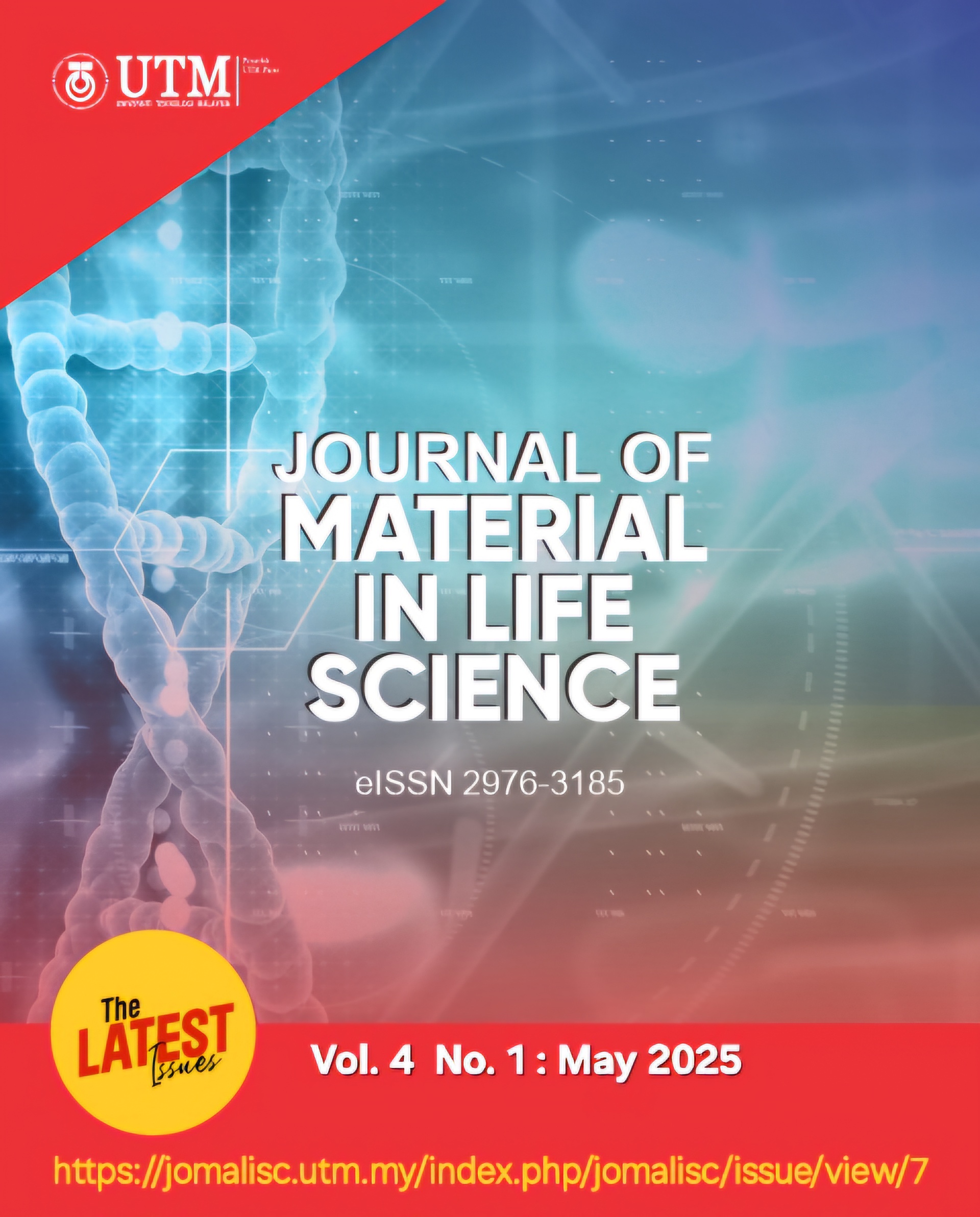Dissolution Behavior of Polysaccharides in Choline Chloride-Based Deep Eutectic Solvents : A Comparative Study of Urea and Oxalic Acid Systems
DOI:
https://doi.org/10.11113/jomalisc.v4.90Keywords:
Deep Eutectic Solvent, Choline Chloride, Urea, Oxalic Acid, Cellulose, Chitosan, Alginate, Polysaccharide DissolutionAbstract
Polysaccharides are essential biopolymers composed of long chains of monosaccharide units linked by glycosidic bonds, serving both structural and storage functions in biological systems. Representative polysaccharides such as cellulose, chitin, chitosan, and alginate possess distinct physicochemical properties and industrial relevance. Cellulose, a β-D-glucose polymer, forms rigid plant cell walls and is resistant to dissolution due to extensive hydrogen bonding. Chitin, present in arthropod exoskeletons and fungal cell walls, and its derivative chitosan offer broad biomedical applications. Alginate, derived from brown seaweed, is appreciated for its gel-forming capacity and biocompatibility. However, the strong hydrogen bonding networks in these polysaccharides hinder their solubility in conventional solvents, necessitating harsh chemical or physical treatment, which is often environmentally and economically unsustainable. Deep eutectic solvents (DES), formed by mixing a hydrogen bond donor (HBD) and hydrogen bond acceptor (HBA), have emerged as a green and cost-effective alternative for polysaccharide processing. These solvents disrupt internal hydrogen bonding through intermolecular interactions, enhancing solubility while preserving structural integrity. This study investigates the dissolution behavior of various polysaccharides in DES systems based on choline chloride combined with urea (CCU) or oxalic acid (COA), with a focus on optimizing parameters such as temperature, component ratio, and HBD type. Dissolution efficiency was evaluated gravimetrically, and ATR-FTIR spectroscopy was used to assess structural changes and interactions. Results revealed that cellulose dissolution in CCU is optimal at temperatures below 90 °C, while temperatures above 100 °C promote carbamation, inhibiting dissolution. Conversely, the COA system induced structural modifications even below 100 °C, suggesting stronger reactivity. Overall, ChCl/urea showed more favorable, non-destructive interactions, indicating its potential as a more suitable DES for polysaccharide dissolution.
References
Poblete, M. R. S., & Diaz, L. J. L. (2014). Synthesis of Biodegradable Cellulose-Chitin Polymer Blend from Portunus pelagicus. Advanced Materials Research, 925, 379–384. https://doi.org/10.4028/www.scientific.net/amr.925.379
Elsoud, M. M. A., & Kady, E. M. E. (2019). Current trends in fungal biosynthesis of chitin and chitosan. Bulletin of the National Research Centre/Bulletin of the National Research Center, 43(1). https://doi.org/10.1186/s42269-019-0105-y
Nataraj, D., & Reddy, N. (2020). CHEMICAL MODIFICATIONS OF ALGINATE AND ITS DERIVATIVES. International Journal of Chemistry Research, 1–17. https://doi.org/10.22159/ijcr.2020v4i1.98
Li, G., & Row, K. H. (2017). Magnetic molecularly imprinted polymers for recognition and enrichment of polysaccharides from seaweed. Journal of Separation Science, 40(24), 4765–4772. https://doi.org/10.1002/jssc.201700947
Frolova, M. A., Tsvetov, N. S., Kushlyaev, R. G., & Drogobuzhskaya, S. V. (2022). Study of the process of dissolution of lanthanum hydroxide in deep eutectic solvents. Transactions of the Kоla Science Centre of RAS Series Engineering Sciences, 13(1/2022), 260–264. https://doi.org/10.37614/2949-1215.2022.13.1.045
Lin, Z., Zhang, Y., Zhao, Q., Chen, A., & Jiao, B. (2021b). Ultrasound‐assisted dispersive liquid‐phase microextraction by solidifying L‐menthol‐decanoic acid hydrophobic deep eutectic solvents for detection of five fungicides in fruit juices and tea drinks. Journal of Separation Science, 44(20), 3870–3882. https://doi.org/10.1002/jssc.202100590
Chen, D., Wang, Z., Wang, L., Zhao, P., Yun, C., & Bai, L. (2023). Structure, catalysis, chitin transport, and selective inhibition of chitin synthase. Nature Communications, 14(1). https://doi.org/10.1038/s41467-023-40479-4
Muñoz-Núñez, C., Fernández-García, M., & Muñoz-Bonilla, A. (2022). Chitin nanocrystals: Environmentally friendly materials for the development of bioactive films. Coatings, 12(2), 144. https://doi.org/10.3390/coatings12020144
Wang, Y., & Wu, P. (2020). Gene Cloning, Characterization, and Molecular Simulations of a Novel Recombinant Chitinase from Chitinibacter Tainanensis CT01 Appropriate for Chitin Enzymatic Hydrolysis. Polymers, 12(8), 1648. https://doi.org/10.3390/polym12081648
Wu, J., Zhang, K., Girouard, N., & Meredith, J. C. (2014). Facile route to produce chitin nanofibers as precursors for flexible and transparent gas barrier materials. Biomacromolecules, 15(12), 4614–4620. https://doi.org/10.1021/bm501416q
Aguilar, A., Zein, N., Harmouch, E., Hafdi, B., Bornert, F., Offner, D., Clauss, F., Fioretti, F., Huck, O., Benkirane-Jessel, N., & Hua, G. (2019). Application of Chitosan in bone and dental engineering. Molecules, 24(16), 3009. https://doi.org/10.3390/molecules24163009
Liu, C., Wang, G., Sui, W., An, L., & Si, C. (2017). Preparation and characterization of chitosan by a novel deacetylation approach using glycerol as green reaction solvent. ACS Sustainable Chemistry & Engineering, 5(6), 4690–4698. https://doi.org/10.1021/acssuschemeng.7b00050
Rosiak, P., Latanska, I., Paul, P., Sujka, W., & Kolesinska, B. (2021). Modification of Alginates to Modulate Their Physic-Chemical Properties and Obtain Biomaterials with Different Functional Properties. Molecules, 26(23), 7264. https://doi.org/10.3390/molecules26237264
Sahoo, D. R., & Biswal, T. (2021). Alginate and its application to tissue engineering. SN Applied Sciences, 3(1). https://doi.org/10.1007/s42452-020-04096-w
Liu, P., Hao, J., Mo, L., & Zhang, Z. (2015b). Recent advances in the application of deep eutectic solvents as sustainable media as well as catalysts in organic reactions. RSC Advances, 5(60), 48675–48704. https://doi.org/10.1039/c5ra05746a
Panhwar, A. H., Tuzen, M., Deligonul, N., & Kazi, T. G. (2018). Ultrasonic assisted deep eutectic solvent liquid–liquid microextraction using azadipyrromethene dye as complexing agent for assessment of chromium species in environmental samples by electrothermal atomic absorption spectrometry. Applied Organometallic Chemistry, 32(5). https://doi.org/10.1002/aoc.4319
Zhang, H., Lang, J., Lan, P., Yang, H., Lu, J., & Wang, Z. (2020). Study on the dissolution mechanism of cellulose by ChCl-based deep eutectic solvents. Materials, 13(2), 278.


















